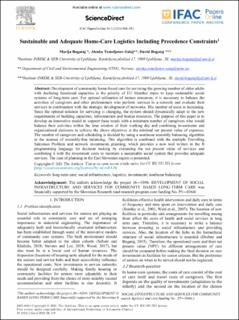| dc.contributor.author | Bogataj, Marija | |
| dc.contributor.author | Temeljotov Salaj, Alenka | |
| dc.contributor.author | Bogataj, David | |
| dc.date.accessioned | 2022-03-11T07:33:18Z | |
| dc.date.available | 2022-03-11T07:33:18Z | |
| dc.date.created | 2021-11-15T22:30:33Z | |
| dc.date.issued | 2021 | |
| dc.identifier.citation | IFAC-PapersOnLine. 2021, 54 (1), 948-953. | en_US |
| dc.identifier.issn | 2405-8963 | |
| dc.identifier.uri | https://hdl.handle.net/11250/2984420 | |
| dc.description.abstract | Development of community home-based care for servicing the growing number of older adults with declining functional capacities is the priority of EU Member states to keep sustainable social systems of long-term care. For optimal utilisation of human resources, it is necessary to balance the activities of caregivers and other professionals who perform services in a network and evaluate their services in combination with the strategic development of networks. The number of users is increasing. Since the optimal solution for servicing is changing, the system should dynamically adapt to the new requirements of building capacities, infrastructure and human resources. The purpose of this paper is to develop an innovative model to support these needs with a minimum number of caregivers who would balance their activities within the time window of their working day and combining investments and organisational decisions to achieve the above objectives at the minimal net present value of expenses. The number of caregivers and scheduling is decided by using a nonlinear assembly balancing algorithm in the manner of assembly-line balancing. This algorithm is combined with the multiple Travelling Salesman Problem and network investments planning, which provides a new tool written in the R programming language for decision making by evaluating the net present value of services and combining it with the investment costs to maintain a sustainable social system that provides adequate services. The case of planning in the East Slovenian region is presented. Keywords: long-term care, social infrastructure, logistics, investments, nonlinear balancing | en_US |
| dc.language.iso | eng | en_US |
| dc.publisher | International Federation of Automatic Control (IFAC) | en_US |
| dc.rights | Attribution-NonCommercial-NoDerivatives 4.0 Internasjonal | * |
| dc.rights.uri | http://creativecommons.org/licenses/by-nc-nd/4.0/deed.no | * |
| dc.title | Sustainable and Adequate Home-Care Logistics Including Precedence Constraints | en_US |
| dc.type | Peer reviewed | en_US |
| dc.type | Journal article | en_US |
| dc.description.version | publishedVersion | en_US |
| dc.source.pagenumber | 948-953 | en_US |
| dc.source.volume | 54 | en_US |
| dc.source.journal | IFAC-PapersOnLine | en_US |
| dc.source.issue | 1 | en_US |
| dc.identifier.doi | 10.1016/j.ifacol.2021.08.112 | |
| dc.identifier.cristin | 1954907 | |
| cristin.ispublished | true | |
| cristin.fulltext | original | |
| cristin.qualitycode | 1 | |

